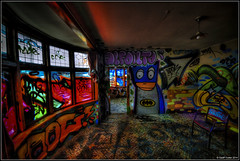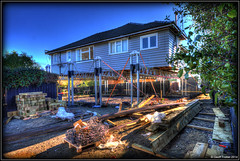
Search
Images for house; more images...
We Lived Here: Oxford Terrace Photograph 002
Images, UC QuakeStudies
A photograph of Robin Duff's house at 386 Oxford Terrace. Weeds have grown near the fence and the grass has not been mowed. A yellow sticker on the door indicates that the access to the house is restricted.
Building Record Form for St Margaret's College Warren House, 61 Papanui Ro…
Articles, UC QuakeStudies
Building Record Form for St Margaret's College Warren House, 61 Papanui Road, Merivale, Christchurch.
We Lived Here: Rees Street Photograph 1
Images, UC QuakeStudies
A photograph of the houses at 5, 7, and 9 Rees Street.
Photograph by Jocelyn Kinghorn 303
Images, UC QuakeStudies
A red-stickered house where a section of the brick wall has crumbled, exposing the inside of the house. Seen through the cordon fence.
We Lived Here: Oxford Terrace Photograph 008
Images, UC QuakeStudies
A photograph of the Locke family's partially-deconstructed house at 392 Oxford Terrace. The photograph has been taken from the footpath in front. Wire fencing has been placed around the outside of the property. A shipping container is resting on the footpath near the right of the property. The photographer comments, "The house was deconstructed over three weeks. The materials were then stored in the shipping container until the house was reconstructed at a new site".
20120702_1387_G12-18 Another one bites the dust
Images, eqnz.chch.2010
8 Velsheda Street, Bexley, Christchurch, across the road from my house was demolished a week or so ago, just one of many demolitions of Red Zone properties at the moment. This house was about ten years old and suffered land damage during the 4th September 2010 and 22nd February 2011 earthquakes. The same fate awaits my house later in the year o...
Campervans to house quake homeless
Audio, Radio New Zealand
Hundreds of camper vans are now ready for the earthquake displaced residents of Christchurch, but the demand for what is cramped and slightly claustrophobic accommodation is yet to be proven.
Streetscape: dialogues of street + house
Research Papers, Lincoln University
An often overlooked aspect of urban housing development is the composition of the space between buildings; the streetscape. The pressures of suppressing suburban sprawl have seen housing developments respond by increasing residential density within more centralised city sites. Medium-density housing typologies are often used as urban infill in response to the challenge of accommodating an increasing population. A by-product of these renewed areas is the creation of new open space which serves as the fundamental public space for sociability to develop in communities. Street space should emphasise this public expression by encouraging social exchange and interaction. As a result, a neighbourhood owes its liveliness (or lack thereof) to its streets. The issue of density when applied to the urban housing landscape encompasses two major components: the occupancy of both the private realms, constituting the residential built form, and the public spaces that adjoins them, the streets. STREETSCAPE: dialogues of street + house. Continual transition between the realms of public and private (building and street space) enact active edges, giving way to public stimulation; the opportunity for experiencing other people. The advent of seeing and hearing other people in connection with daily comings and goings encourages social events to evolve, enhancing the notion of neighbourly conduct. Within New Zealand, and specifically in Christchurch as considered here, the compositions of current streetscapes lack the demeanor to really encourage and facilitate the idea of neighbourly interaction and public expression. Here lies the potential for new street design to significantly heighten the interplay of human activity. In response, this research project operates under the notion that the street spaces of urban residential areas are largely underutilised. This lack is particularly evident in the street. Street design should strive to produce spaces which stimulate the public life of residents. There exists a need to reassert eminence of the street as a space for vibrant neighbourhood life. This thesis employs design as a tool for researching and will involve using numerous concept generators to trigger the production of multiple scenarios. These scenarios are to explore the ways in which the streetscapes within medium-density urban communities could respond in the event of (re) development.
We Lived Here: Oxford Terrace Photograph 099
Images, UC QuakeStudies
A photograph of Robin Duff's house at 386 Oxford Terrace. The garden is overgrown and one of the windows has been boarded up with plywood. A yellow sticker on the door indicates that the access to the house is restricted.
We Lived Here: Oxford Terrace Photograph 038
Images, UC QuakeStudies
A photograph of the house at 432 Oxford Terrace, taken from the property next door. Wire fencing has been placed along the fence between the two properties. A yellow sticker on the front door of the house indicates that access is restricted.
We Lived Here: Oxford Terrace Photograph 100
Images, UC QuakeStudies
A photograph of Robin Duff's house at 386 Oxford Terrace. The garden has overgrown and one of the windows has been boarded up with plywood. A yellow sticker on the door indicates that the access to the house is restricted.
We Lived Here: Oxford Terrace Photograph 115
Images, UC QuakeStudies
A photograph of the former site of the Locke family's house at 392 Oxford Terrace. The Locke's house was deconstructed after their land was zoned Red. The photographer comments, "The house was deconstructed and rebuilt on another site". Grass has grown over the site.
We Lived Here: Oxford Terrace Photograph 095
Images, UC QuakeStudies
A photograph of 386 and 378 Oxford Terrace, taken from across the road. The former site of Doug Sexton's house is on the right, behind the wire fence. Sexton's house was demolished after his land was Red zoned.
We Lived Here: Bangor Street Photograph 11
Images, UC QuakeStudies
A photograph of the former site of a house at 57 Bangor Street. The house was demolished after the land was zoned Red. The houses in the background have also been demolished, so that Oxford Terrace is visible in the distance.
We Lived Here: Oxford Terrace Photograph 086
Images, UC QuakeStudies
A photograph of the former site of the house at 466 Oxford Terrace, taken from the site next door. The house was demolished after the land was zoned Red. Wire fencing has been placed around the site as a cordon.
Christchurch man challenges insurer to live in his house
Audio, Radio New Zealand
A Christchurch man, whose house was damaged in the earthquakes, has challenged his insurer's CEO to live in it if she truly believes it's repairable.
Architecture graduate turned illustrator celebrates beauty of New Zealand …
Audio, Radio New Zealand
Josh Currie sells hand-drawn illustrations of houses, including requests from people whose much-loved homes were lost to tragedies like housefires or the Christchurch earthquakes.
Photograph of 51 Laurence Street (1)
Images, UC QuakeStudies
A photograph of the earthquake damage to a house at 51 Laurence Street. A red sticker in the window indicates that the house is unsafe to enter.
We Lived Here: Oxford Terrace Photograph 025
Images, UC QuakeStudies
A photograph of the house at 402 Oxford Terrace, taken from the footpath.
We Lived Here: Oxford Terrace Photograph 062
Images, UC QuakeStudies
A photograph of Siobhan Murphy outside her house at 436 Oxford Terrace.
We Lived Here: Oxford Terrace Photograph 112
Images, UC QuakeStudies
A photograph of the house at 396 Oxford Terrace, taken through two overgrown bushes.
NOW.... "We built here because we love the character of the bays". SOON...…
Images, Alexander Turnbull Library
In the first of two frames which represents 'now' is a row of houses in the bay; two old-style character villas flank a modern house built to look like a boat and someone inside the modern house says proudly that they 'built here because of the character of the bays'. In the second frame which represents 'soon' all of the houses have taken on the character of the modern house and someone from the original modern house can't put their finger on why they feel that 'It's not the same somehow'. Quantity: 1 digital cartoon(s).
We Lived Here: Oxford Terrace Photograph 050
Images, UC QuakeStudies
A photograph of Siobhan Murphy's house at 436 Oxford Terrace. The photograph was taken from the empty lot next door. The front of the house has been covered with plastic sheeting. Wire fencing has been placed around the outside of the property as a cordon.
We Lived Here: Oxford Terrace Photograph 057
Images, UC QuakeStudies
A photograph of Donna Allfrey, her husband Lex, and their two dogs, Niko and Zeus, sitting on the front steps of their house on Oxford Terrace. A green sticker on the door behind them indicates that the house has been inspected and is safe to enter.
We Lived Here: Oxford Terrace Photograph 127
Images, UC QuakeStudies
A photograph of the house at 402 Oxford Terrace. The grass has been mowed, but the dead grass has not been removed. A red sticker on the door indicates that the house in unsafe to enter. In the foreground, the letterbox is sitting on an angle.
Building Record Forms for Wesley Home for Aged (McKellar House), 138-148 P…
Articles, UC QuakeStudies
Building Record Forms for Wesley Home for Aged (McKellar House), 138-148 Park Terrace, Christchurch.
Quake-hit state house tenant withholds rent
Audio, Radio New Zealand
A state house tenant in the Christchurch suburb of Avonside is withholding her rent, saying Housing New Zealand has left her in the lurch following the big earthquake.
Fairfax Video October 2012 (2)
Videos, UC QuakeStudies
A time-lapse video of the demolition of Shadbolt House, also known as the Harbour Board building.
Photograph of Cecil House, 69-73 Manchester Street (3)
Images, UC QuakeStudies
A photograph of the front door of Cecil House on Manchester Street. A red sticker on the door indicates that the building is unsafe to enter.
We Lived Here: Oxford Terrace Photograph 074
Images, UC QuakeStudies
A photograph of the hallway of Donna Allfrey's house at 406 Oxford Terrace.



